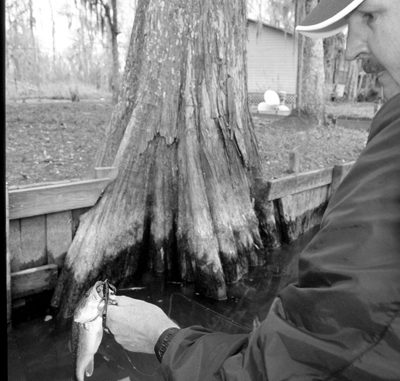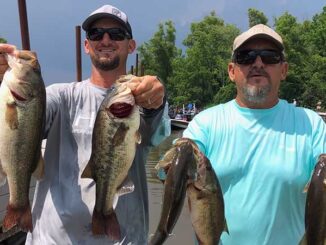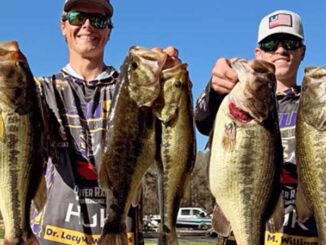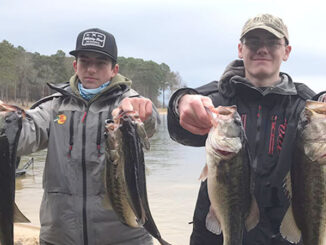
Spring is when the rivers of the Florida Parishes produce their heaviest bass, but fishing the current-filled waterways can be tough. These two anglers share tips on how to tame the rivers.
Roger Boler’s lure split the water beside the cypress tree soundlessly, barely making a ripple. The current ripping around the tree’s trunk and root system began pulling it southward, but the line suddenly jumped minutely, a signal that would be missed by all but the most observant angler.
Boler saw the telltale sign and set the hook on the first fish of the day.
The feisty bass, which weighed about a pound, was soon flipped in the boat, unhooked and tossed overboard.
The 6-inch worm at the end of Boler’s line was quickly readjusted and flipped to another cypress tree.
The Slidell pro angler worked every current-break along the stretch of river, pulling fish from logs, stumps, cypress knees and grass.
“They’re looking for a place to get out the current,” said Boler, who was fresh off a second-place finish during a BASSMASTER Tour stop in Florida.
By the end of the trip, the Slidell pro had put 10 or 12 fish in the boat, but the big bite had eluded him.
It was just another day on a Florida Parish river, which can be frustrating or rewarding depending upon the time of year and weather conditions.
But Boler wasn’t disappointed — he knew the time was approaching when bigger bass would seemingly materialize and begin the task of producing the next generation of bass.
The rivers along the north shores of Lakes Pontchartrain and Maurepas aren’t known as bass meccas among the South Louisiana fishing community. After all, the average catch there is far from show-stopper caliber.
But March begins the time of year when anglers can catch 3-pound bass, and even the occasional fish that surpasses that mark, for a few weeks.
“The spawn is going to produce your big sows,” Mandeville angler Danny Owens said.
Like on any waterway, water temperature is the key to the beginnings of the spawn.
“It’s got to get in the mid to upper 50s for them to know it’s time to move up,” Owens said. “If I get 60-degree water, I’m going to be looking closer to the bank.”
Catching staging and bedding fish in a riverine system befuddles some anglers. But it’s really no problem, according to Boler and Owens.
“It’s all about knowing what the depths are and what a good flat is,” Owens said.
The Florida Parish rivers — the Pearl, the Tchefuncte, the Tangipahoa and the Tickfaw — are in most ways very similar. They are typified by a deep channel with small feeder creeks and sloughs draining the surrounding marsh.
Boler, who cut his bass-fishing teeth on the West Pearl, said the key to springtime success is to find shallow areas out of the current.
“They spawn in shallow areas — docks, behind cypress knees and in the root system of cypress trees,” he said.
But he recommended looking for areas that aren’t right off the current.
“See that cypress tree,” Boler said, pointing out a large tree about 6 feet in diameter. “The fish won’t be on the outside part of the tree because that current is still ripping through the roots.
“It’ll be behind the tree, nearer the bank.”
Also, there are stretches of bank that are out of the current because of the location of the channel.
“If you get one of those long curves in the river, the channel is going to be on the outside of the turn,” Boler said. “That’s where your current is going to be.”
The inside of the bend will feature much weaker water movement, and can even have areas where eddies push the water slowly upstream.
While he fishes the main rivers much of the time, Boler also will work any bayous, sloughs or cuts off the waterway.
“I think their favorite places are canal systems,” he said.
Finding any canal cut off the particular river he’s fishing is heaven for Boler, who immediately begins working the calm, still waters.
The reason goes farther than any lack of current, though.
“The thing about these rivers is they flash-flood so easily if you get a hard rain,” Boler said. “Even a bayou has the potential of being blown out.”
Owens agreed that the banks provide perfect spawning conditions, with relatively calm and clear-water conditions.
“I like 2 to 4 feet of water that also has 8 to 10 feet of water nearby for them to escape to,” the B.A.S.S. Federation member said. “They’ll stage in that 6 to 8 feet of water, and then they’ll move up into that 2 to 3 feet of water to spawn.”
When a fish moves into the shallows, the water often is clear enough for them to be sight-fished.
“You can see them next to the bank,” he explained.
The key to sight-fishing is patience.
“If I’m sight-fishing, a lot of times I’ll just leave the bait in one place and force-feed the fish,” Owens said.
He simply gives his lure subtle twitches to try to aggravate the fish he’s watching.
“If I see one, I can generally get it to bite. It might take me five minutes or 30 minutes, but I can usually catch that fish,” Owens said.
Even if the water gets muddied by a rain, however, the fish are still going to spawn there.
“The fish are still there; you just don’t see them,” Owens said.
That calls for a more aggressive retrieve.
“In that situation, I’ll pop that bait more,” he said. “You need more noise, more scent, more movement to make the fish notice it.”
Bank beating isn’t exactly a secret in South Louisiana, though, so there’s plenty of competition for the bite.
Owens said that fighting the crowds isn’t always necessary, however — if you know where else to look.
“The fish will probably be against the bank, but there are a bunch of fish that are overlooked by anglers,” he said. “I’ve seen fish spawn in Toledo Bend in 15 feet of water.
“If they’ll do that there, they’ll do that here.”
Fish accomplish this feat in the face of stronger currents by tucking in on the down-current side of grass, treetops and even underwater mounds or bluffs, Owens said.
“I may be 20 feet off the bank, but I know there’s a treetop or a mound under me,” he said.
And while many fish will spawn in these deeper-water areas, anglers should also keep in mind that fish preparing to move to the shallows will be lurking around deep-water current breaks.
“Staging fish will come up around those areas,” Owens said.
The beauty of finding a mound, a bluff, a grass line or treetop away from the bank is that bass are afforded a place to stage to move up or spawn even near the channel.
Finding these productive areas, however, takes patience and an eye for a depth finder.
“These areas can be in a straightaway in the system, and unless you go slow and graph it, you don’t know they’re there,” Owens explained.
The only difference in working deep current breaks and those in the shallows is that there is no possibility of actually seeing the bass you’re fishing.
Therefore, Owens uses the same technique as when his sight-fishing areas muddy up — he drops his lure to the bottom and crawls it along.
Lure choices are pretty standard for the spawn.
Boler uses lizards, creature baits, small worms and jigs much of the time, but he also doesn’t mind turning to a blade.
The key to spinnerbait fishing when fish are on beds is to remember that they aren’t going to chase a bait far.
So Boler crawls his spinnerbait along the bottom, bumping it into anything he can.
“I always try to run it into something,” he said. “If you run it into a root, the fish will feel it 10 feet away.
“It’s just something to let him know the bait’s there.”
Anyone who has fished bass during the spawn knows that short-strikes are common.
Boler relies on a modification to up his odds of success of nabbing bass that swipe at his blade.
“A lot of times they’re just nipping at it to get it away, especially when they’re on beds,” he said. “I always have a trailer hook because I’ve caught so many big fish just by the lip.
“It can be worth your while.”
When he’s fishing plastics or jigs, Boler said he continues to probe the root systems on the downcurrent side of cypress trees.
“They’ll be in those roots where the current is slack,” he said “You know as well as I do how big those root systems are.”
To catch staging fish, he’ll work the lures to the deeper water, dropping them off any shelf and closely watching his line for that “tick” indicating a strike.
Owens relies mostly on plastics and jigs, with his favorite plastics being tubes and lizards.
“If you put a tube or a lizard in its bed, it’s going to pull it out of there,” he said.
When Owens is using a tube, he will often rig his plastics with an exposed hook to increase the odds of a hook-up.
“There are times when I’ll use a jighead,” he said.
These aren’t the same jigs as used to fish saltwater areas, and they aren’t brushed like traditional bass jigs.
Instead, they are basically a 3/0 hook formed into a bullet weight.
“If a fish bites it, it’s much easier to hook the fish,” Owens said.
Of course, heavy-cover situations call for the hook to be covered with plastic.
“If I know there’s a lot of cover, I’ll Texas rig it and thread it back into the plastic,” he said.
Lizards also are a great choice, and Owens uses miniature and larger models.
“I’ll start with a small one,” he said.
Another trick he’s learned to drive spawning bass nuts is to toss weightless lizards. This is effective because the lure looks more natural than one bumping around on the bottom.
“Anything you can throw that is as natural as possible in the water, the easier it is to hook a fish,” Owens explained.
When he weights his plastics, however, he tries not to use tackle that’s too heavy — a mistake many anglers make because of the current.
“The tendency is to fish a heavier weight so you can have more feel,” he said. “I fall into that too, but I’m not going to shy away from fishing 8-pound line with an 1/8-ounce or 1/16-ounce jighead on a tube or creature bait.”
Heavy line and weights are only necessary when snatching fish out of tight cover, he said.
The different rivers do, however, sometimes dictate heavier tackle.
“The Pearl River is different,” Owens said. “The water’s flowing a lot faster.
“You’re going to have to use heavier tackle.”
The Tchefuncte is slower, while the Tangipahoa is downright sluggish.
The former allows the use of 8- to 12-pound line with matching weights, while the latter calls for light-tackle applications.
“I don’t feel (the Tangipahoa) has much current at all, so I stick with light line (and weights),” Owens said.
Current in the Tickfaw, which drains into Lake Maurepas, isn’t as swift as in the Tchefuncte or as slow as in the Tangipahoa, he said.


